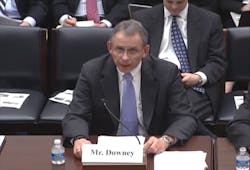Congress should take steps to make hazardous materials shipments more efficient and cost-effective while continuing to ensure safety and security, the American Trucking Assns. and the National Tank Truck Carriers told a House committee April 2.
Testifying on behalf of ATA and NTTC at a House Transportation & Infrastructure hazardous materials subcommittee hearing on reauthorization of hazmat programs, William Downey, executive vice president for corporate affairs and chief security officer at The Kenan Advantage Group, called on Congress to take three actions:
- Limit the requirement for fingerprint-based background checks to drivers transporting security-sensitive hazardous materials. The background check costs $86.50 in states that use the Transportation Security Administration’s contractor and as much as much as $150 in states that perform the check themselves, Downing said. Limiting the checks to drivers transporting security-sensitive hazmat materials could “save commercial drivers and the federal government both time and money without compromising security,” Downey said.
- Block the Pipeline and Hazardous Materials Safety Administration (PHMSA) from issuing its proposed “wetlines” regulation. As currently proposed, the rule would require the purging of liquids from the piping used to load and unload tank trucks. The tank truck industry has questioned the cost and justification of the plan, and Congress had blocked the rule until GAO had studied the issue. The GAO report concluded that PHMSA needs to improve its data gathering and improve its cost-benefit analysis.
- Reform the state hazardous materials permitting process. Even though federal regulations bar states from imposing hazmat rules that are substantially the same as federal rules, some states still require permitting, Downey said. While carriers would prefer to do away with these duplicative permits, at a minimum states should be required to join the Alliance for Uniform Hazmat Transportation Procedures, which has been formed by Michigan, Nevada, Ohio, Oklahoma and West Virginia. Alliance states have combined their application processes online so a carrier can visit the site once, provide all the necessary information, select the states in which it hauls hazardous materials and pay a single registration fee.
Downey’s prepared comments on behalf of ATA alone addressed a fourth issue: The need for clarity in hazmat accountability by distinguishing the functions performed by shippers versus those performed by carriers. The federal hazmat rules govern the packaging, marking and labeling of hazardous materials and impose other requirements that vary based upon each individual material being transported, Downey noted.
“As the party that knows the specific qualities of their products, shippers are tasked with complying with these regulations,” Downey said in the ATA testimony. “But, because most violations are discovered during roadside inspections, drivers and motor carriers frequently receive citations for violations of the hazardous materials regulations that they cannot reasonably be expected to discover, know of, or prevent.”
On the wetlines issue, PHMSA Administrator Cynthia Quarterman told the subcommittee that the agency is still reviewing GAO’s criticisms. “Then we will determine whether we withdraw the rule or improve on it.” Regardless of whether PHMSA issues a rule, however, the agency will continue to pursue ways to improve wetline safety. Officially, PHMSA plans to submit a final rule for White House review by the end of April, according to the latest Dept. of Transportation monthly report on rulemaking status.
Asked what the industry proposes instead of the wetline rules, Downey said that carriers could put the dollars into training or direct them to technologies that would prevent accidents, such as anti-rollover systems.
The Federal Motor Carrier Safety Administration did not escape attention at the hearing. Steven Pelkey, speaking on behalf of the American Pyrotechnics Assn., asked Congress to push reforms of FMCSA’s Hazardous Materials Safety Permit program. The HMSP is based not just on a satisfactory safety rating but also staying below specified out-of-service violations and crash rate thresholds, noted Pelkey, who is president and chief executive officer of Atlas Advanced Pyrotechnics.
The HMSP program is flawed because it takes 14 clean inspections to erase the effects of one bad inspection, but the system is not set up to record clean inspections, Pelkey said. This challenge is amplified for pyrotechnics transporters because they don’t typically get inspected often to begin with due to their size and the fact that most of the transportation is seasonal around the Fourth of July and New Year’s Eve. On top of this, carriers are frustrated that the DataQs program is not an effective way to correct the bad inspections they do get, he said.
Atlas lost its permit in 2011 as a result of several erroneous OOS violations, meaning that it could haul no more than 55 lbs. on one commercial motor vehicle, Pelkey said. At peak demand, this meant using eight to 10 trucks to haul what could have been hauled with one truck.
“As you can imagine, placing additional trucks on the road to deliver Division 1 explosives to a display site rather than transporting all of these products in one vehicle does not enhance public safety nor does it satisfy the spirit of safety intended with the HMSP program,” Pelkey said.
